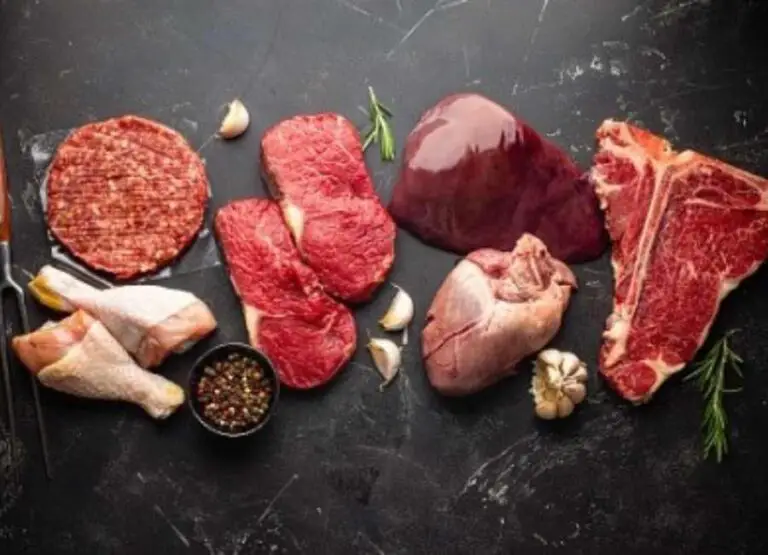14 Reasons Why Humans Should Eat Meat
If you are wondering why humans should eat meat then this post is for you because in this article we will outline the reasons why humans should eat meat.
We all know the benefits of eating meat. Protein, iron, and B vitamins are just some of the nutrients found in meats.
Meat is an essential part of the human diet. It provides our bodies with proteins, vitamins, and minerals that are necessary for proper muscle and organ function.
But what if you’re a vegetarian or vegan? You might think that because your diet doesn’t include meat, you’re immune from nutrient deficiencies, but that’s wrong.
This article will explore why humans should eat meat and why it’s important to maintain a healthy balance between plant-based foods and animal products in your diet.
Also, check out 13 disadvantages of eating meat you should know.
Reasons Why Humans Should Eat Meat
Meat has been a part of human culture for many years. It is one of the best sources of protein, iron, and zinc.
For these reasons, it is important to consume lean proteins like meat in order to maintain a healthy lifestyle.
There are many misconceptions about eating meat, but you don’t have to worry about these because here are some reasons why humans should eat meat:
Meat provides the human body with lots of vitamins
Meat is high in vitamins, which are essential for sustaining good health.
Note: Meat is particularly high in vitamin E as well as B vitamins like B2, B6, and B12.
Meat has high levels of vitamin E, which has significant antioxidant qualities and aids in reducing the damage caused by oxygen to cells, allowing for quicker muscle repair and recovery.
The majority of the vitamins contained in meat work together to aid in the conversion of food into energy, but they also have separate purposes and functions.
Vitamin B2 is required for the formation of red blood cells, which transport oxygen throughout the body, vitamin B6 is required for protein synthesis, while vitamin B12 is required for proper nerve function.
As a result, meat is high in vitamins that people require for day-to-day activity.
Meat provides the human body with lots of minerals
Meat contains a wide range of minerals that help your cells and tissues operate properly. It is, for example, a significant source of both iron and zinc.
Meat contains iron, which helps deliver oxygen to and through your tissues, and zinc, which is needed for a healthy immune system, wound healing, and enzyme function within your cells.
Magnesium is beneficial to bone health because it aids in vitamin D synthesis and reduces net acid generation.
It’s considered that consuming magnesium through food might help prevent osteoporosis.
Note: Meat also includes phosphorus, which helps to keep your bones healthy, sulfur, which may be converted into new amino acids, and chromium, which aids in the metabolism of carbohydrates in your diet.
Meat aids to stabilize blood sugar levels in the body
Meat helps to keep blood sugar levels stable because of its high protein and fat content.
In order to avoid type 2 diabetes and other chronic diseases, it’s critical to keep blood sugar levels constant.
It also aids in the maintenance of energy levels and creates a feeling of fullness in-between meals, reducing the desire for unhealthy foods.
When your blood sugar is stable, you’re less likely to want fatty snacks and sweets in between meals.
Meat aids the growth and maintenance of tissues in the body
The protein included in meat is necessary for tissue development and maintenance.
Your body’s protein requirements are determined by your health and exercise level.
Body tissues are broken down over time, and the body needs protein for the continued growth and development of tissues.
Since meat is a high protein source, eating meat can provide the protein your body needs to maintain tissues.
Meat provides extra Selenium for humans
Half of a human’s daily selenium requirements are met by a plate of beef or lamb.
Selenium is an antioxidant that protects cells from harm, supports thyroid function, and may help prevent cancer.
Selenium is also known as a powerful antioxidant that fights oxidative stress and helps defend your body from chronic conditions, such as heart disease and cancer.
Pork, beef, turkey, chicken, fish, shellfish, and eggs contain high amounts of selenium. Some beans and nuts, especially Brazil nuts, contain selenium.
Meat help provide the body with long-lasting energy
Simple carbohydrates are broken down into sugar, which our bodies quickly burn through, resulting in a collapse.
Our bodies, on the other hand, use the protein in meats to provide us with long-lasting energy.
Orexin cell activation is connected to increased energy expenditure and alertness.
Amino acids excite orexin cells more than any other foodstuff, according to researchers at the University of Cambridge.
As a result, eating animal protein causes you to burn more calories and expend more energy.
Weight gain and narcolepsy have been related to decreased activity in orexin cells.
Meat provides the human body with 96% of the essential nutrients needed
Meat contains several nutrients that are essential for the general health of humans.
While there are several protein sources, meat is a particularly good source of complete protein.
As it contains all of the amino acids our bodies require, even some that our systems cannot manufacture.
Meats have higher concentrations of all B vitamins than plant sources, and vitamin B-12 is solely found in animal sources.
B vitamins are essential for good health, particularly mental wellness.
Confusion decreased senses, aggressiveness, sleeplessness, weakness, dementia, and peripheral neuropathy are among the symptoms of vitamin deficiencies.
Meat provides 99.9% protein for humans
Protein is a nutrient that aids in muscle development and repair, as well as the maintenance of healthy hair, bones, skin, and blood.
Meat is a good source of protein, which is necessary for a balanced diet, according to research.
Note: Meat consumption also aids in bodybuilding.
Meat with a high biological value is excellent for everyone, and a protein obtained from meat is readily digested and so absorbed rapidly and efficiently by the body.
Red meat, chicken, and turkey, on the other hand, are exceptionally high in protein.
However, it should be taken in moderation; you can learn more about high-protein meat here.
As a result, meat is extremely vital due to its high protein content.
Meat supports healthy neurotransmitters in humans
Because meat protein contains all of the necessary amino acids that human bodies require.
Those who don’t consume meat are more sensitive to neurotransmitter abnormalities.
Neurotransmitters are chemical messengers that control a variety of processes in our bodies, including our physical, cognitive, and mental abilities, as well as our sleep cycle, weight, and emotional moods.
Meat protein contains all of the necessary amino acids required by humans.
Non-meat eaters are particularly susceptible to neurotransmitter imbalances, which can lead to sadness, anxiety, and hyperactivity.
Vegetarians are two to three times more likely than meat-eaters to suffer from melancholy, anxiety, eating disorders, and somatoform illnesses and syndromes, according to a study done at the University of Graz.
Meat helps weight management in humans
Diets high in protein, such as those including lean meat and poultry, have been found to stimulate weight reduction over longer periods of time than other diets.
Not all meat cuts help in weight management, but specifically, lean cuts can aid in weight management.
Meat supports bone strength in humans
Meatless diets have been found to have reduced levels of calcium, vitamin D, vitamin B-12, protein, and omega-3 fatty acids, all of which are essential for bone health.
Meat on the other provides all the nutrients required for bone formation and bone maintenance.
Meat supply iron that helps prevent anemia in humans
Heme iron is present in meat, fish, and poultry, and it helps to prevent anemia because the body absorbs it better than non-heme iron found in plant foods like vegetables.
Heme iron foods aid in the absorption of non-heme iron.
Iron is required for the formation of blood. About 70% of your body’s iron is contained in hemoglobin, which is found in red blood cells, and myoglobin, which is found in muscle cells.
Hemoglobin is required for the transport of oxygen from the lungs to the tissues in your blood.
Meat promotes wound healing in humans
Zinc improves wound healing and helps to maintain healthy immunological function. Beef is the most important dietary source of zinc.
Zinc is present in every cell of the body. It is required for the correct functioning of the body’s defense (immune) system.
It is involved in cell division, cell development, wound healing, and carbohydrate breakdown. The senses of smell and taste require zinc as well.
Meat provides Carnosine to humans
Another benefit of eating meat is that it contains a lot of carnosine.
Carnosine (beta-analyl-L-histidine) is an amino acid that may be found all over the body and plays a number of essential functions in human health.
Another health benefit is that meat is one of the largest sources of carnosine (having around 50 percent more than poultry).
Carnosine also helps to strengthen the immune system and decrease inflammation.
The amino acid is also considered to protect our cells from lipid peroxidation.
Final Thought
Eating meat has been a part of human culture for centuries. It is integral to what we do and how we think.
In addition to providing the iron and protein that our bodies need, it also provides essential vitamins and nutrients that cannot be found in any other food source.
But as our lifestyles change, so do our eating habits. Eating meat is not bad, but the quality and quantity of meat you eat should be something you consider.
So, to summarize what are the advantages of consuming meat for your health?
Meat is high in protein and vitamin B-12, as well as iron, so it’s simple to understand how including meat in their diet may have helped our forefathers survive.
Protein is now much simpler to get by, as it may be found in nuts and beans, for example.



![Why Is My Frozen Ground Beef Brown [Answered]](https://foodcreeks.com/wp-content/uploads/2023/03/Frozen-Ground-Beef-Brown-768x555.jpg)


![Can You Eat Smoked Sausage Raw [Explained]](https://foodcreeks.com/wp-content/uploads/2023/02/Can-You-Eat-Smoked-Sausage-Raw-768x555.jpg)
![Can Pregnant Women Eat Uncured Meat [Answered]](https://foodcreeks.com/wp-content/uploads/2023/02/Can-Pregnant-Women-Eat-Uncured-Meat-768x555.jpg)